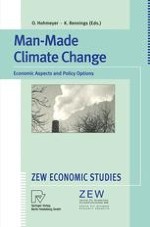1999 | OriginalPaper | Buchkapitel
The Kyoto Protocol and the Emergence of “Contraction and Convergence” as a Framework for an International Political Solution to Greenhouse Gas Emissions Abatement
verfasst von : Aubrey Meyer
Erschienen in: Man-Made Climate Change
Verlag: Physica-Verlag HD
Enthalten in: Professional Book Archive
Aktivieren Sie unsere intelligente Suche, um passende Fachinhalte oder Patente zu finden.
Wählen Sie Textabschnitte aus um mit Künstlicher Intelligenz passenden Patente zu finden. powered by
Markieren Sie Textabschnitte, um KI-gestützt weitere passende Inhalte zu finden. powered by
The Kyoto Protocol, completed in the early hours of December 11th 1997, at present is no more than a potential breakthrough in the development of effective global policy for the control of atmospheric concentrations of greenhouse gases and the mitigation of human-induced global climate changes. The core issue of the negotiations has been deferred until CoP4 in November 1998. The industrial countries have negotiated a compromise that subject to ratification will legally bind them to commitments beyond those in the UNFCCC. But the ratification of the Protocol by the US still remains contingent on achieving the “meaningful participation” of “key” developing countries in the abatement regime and the multilateral acceptance of international emissions trading. This is a struggle to define property rights. These key developing countries include India and China and they have made it clear that their acceptance of trading is contingent on the achievement of “equitable allocations” of emissions entitlements based on achieving equal per capita entitlements globally. COP issued instructions to the technical bodies attached to the UNFCCC to “define the relevant principle, modalities, rules, and guidelines for emissions trading” in time for CoP4 in November 1998 in Buenos Aires.
